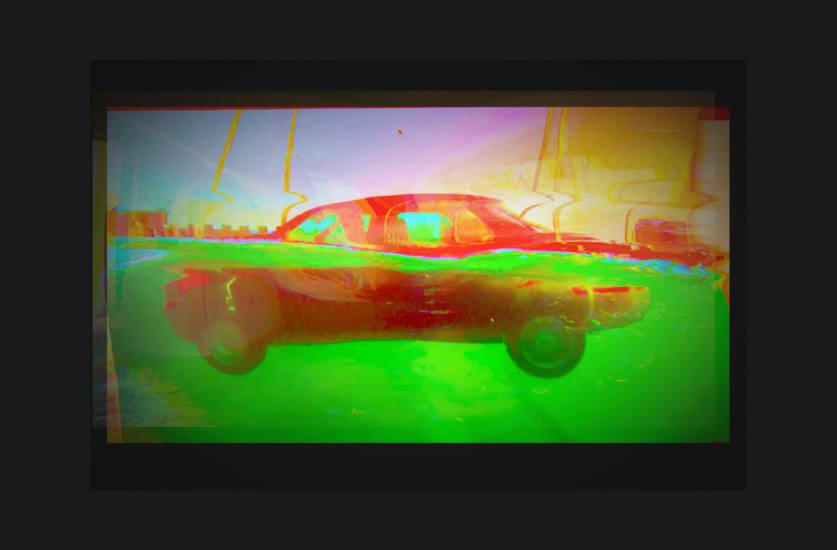The video has the feel of college roommates pulling a prank. “Holy cow that’s cold!” Jessi Coombs says, as the water rises over her ankles. “It’s coming in, it’s right around my feet.”
Coombs is sitting behind the wheel of a red four-door — it’s just been dropped from a crane and is sinking rapidly into a quarry. “My heart is definitely beating,” she tells the camera mounted on the dash. Water rushes into the car. It’s preternaturally quiet. No screaming, no thrashing, just the occasional nervous laugh as the water bubbles up around Coombs’ chest, still cinched by her seatbelt.
The disaster infotainment video genre swerves between public service, spectacle, and nightmare visualization aid
When the water reaches her chin, she takes a deep breath. Once the car fills entirely with frothing water — she’s been waiting for the pressure inside and outside the car to equalize — we see her pushing at the door; a new camera angle shows us the submerged car from the outside, her small white palms pressing desperately against the window glass. The car door resists her for a heart-stopping moment, then gives way; Coombs swims out and breaks the surface to a surge of music invoking sunrise, dolphins, and the triumph of the human spirit.
Coombs is the co-host of a YouTube series called The List, an infotainment adventure show about cars, and this is episode 147: “How to Escape A Car Underwater.” Sitting safely at my desk, watching my computer screen positioned between a thermos of tea, a rangy cyclamen, and a pile of mail, my body believed I was in the sinking car with Coombs — I gasped for air, realizing that I had been holding my breath. The disaster infotainment video genre walks a zigzag line, swerving between public service, spectacle, and nightmare visualization aid. It packages together the paranoid’s obsessive catastrophization with the star-pupil’s faith in the all-conquering power of doing as we’re told.
The idea that tsunamis, shark attacks, explosions, parachute malfunctions, and plane crashes can all be outsmarted with a few simple tips fantasizes a world in which information — and the thinking human animal — can solve any problem. The fragility of our bodies can surely be overcome by the superior power of our minds. The series Epic How-To dramatizes how to fend off a lion attack, outwit a hitman, rise from a buried coffin, fight a bear, and survive a shipwreck — all in the most awesome-bro way possible. Bright Side, an aggregator specializing in optimism, offers an endearing cartoon on how to survive a free-falling elevator. In 1945, lift operator Betty Lou Oliver fell 79 stories down the Empire State building; she lived to foxtrot another day, and so can you!
The most escapist of these scenarios invite us to imagine ourselves as action heroes, inhabiting a dream in which physical pain can’t intrude
Most of us will never need to best a lion in hand-to-hand combat. The most escapist of these scenarios invite us to imagine ourselves as action heroes, inhabiting a dream in which physical pain can’t intrude. Danger is entertainment, and getting into a fight with a bear is like an extreme snowboarding trick. The amorality of nature — the fact that fire will burn us and water drown us without stopping to ask our names or consider how much talent or love we have to give — doesn’t compute. We tend to believe the world was created for our self-actualization. So how can individual merit fail to save us?
A nation premised on a myth of bootstrap meritocracy can’t help but fall back on a misplaced faith in individual responsibility in the face of collective catastrophe caused by systemic failure. In 1951, the U.S. Civil Defense agency, in cooperation with public schools in New York, produced a film about a cartoon turtle named Bert. A female doo-wop group sings the watchwords the film is named for: Duck and Cover. Remember, a smooth baritone chides, the bomb might explode when there are no grownups around — you’ll have to take care of yourself. A teacher points to the blackboard, on which she’s written out the two types of nuclear attacks: “with warning,” and “without warning.” Rows of students nod intelligently. Communism will be no match for the all-American child.
Today’s decentralized equivalent is the spool of online disaster infotainment videos by news outlets and security experts, all with variations on the same title: “How to Survive a Mass Shooting.” The difference is that the disaster has happened, is happening, will happen. The advice and the drills are not theoretical, and there is very little consolation on offer. Run, hide, barricade the door. If the worst comes, attack the shooter with shoes, pencils, and your bare hands. Or meet this eminently avoidable catastrophe with your ace card: Pretend you are already dead.
Ultimately, series like The List are guilty of creating a risk all their own: death by misinformation. A 2017 article in the journal Cogent Engineering explains, “In most vehicle submersion scenarios, the only way to survive is to exit through the side windows, which need to be opened or broken within about one minute of the vehicle impacting the water.” Anyone who waits calmly the two to four minutes it will take for the water to rise over their head will almost certainly die. The study’s authors, a joint engineering and kinesiology team, are working on a mechanism that could save lives: an automatically triggered window-opening system. “If occupants do not know, or forget, what to do, the open window could hopefully prompt them to exit safely through that window,” the study concludes. Our best hope of surviving disaster may be in designing solutions that don’t depend on human presence of mind.
